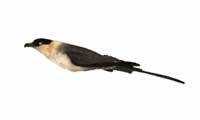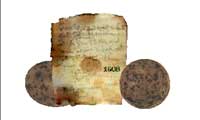|
Dr. Anderson, his colleagues and their assistants, members
of both the Northern and Southern Parties, collected about 600 specimens of birds,
mostly skulls and skins, but also numbers of eggs and nests. The collections represent
at least seventy-three different species.
 |
 |
 |
Male long-tailed jaeger shot by Palaiyak
at Bernard Harbour, Nunavut, on June 30, 1916.
3-D model: Paul Bloskie, © Canadian Museum of Nature.
- Pointstream Version (490 Kb)
- Quicktime Version (240 Kb)
|
|
You need Pointstream 3DImagePlayer in order to manipulate this
3D image. Download this
plug-in. You must be using Microsoft Windows and Internet Explorer 4.0 or greater.
To rotate the image, click on it and move your mouse. To zoom in and out, right-click
on the image while moving your mouse.
QuickTime allows you to rotate the image horizontally. Download
QuickTime player
|
Yellow-billed Loon
This is the loon of the treeless tundra of the western Arctic.
Once considered the same species as the very similar common loon of southern Canada,
the yellow-billed loon is now recognized as a closely related but different species.
The yellow-billed loon is generally more robust than the common loon, with differences
in the shape and colour of the bill, and in the feather pattern of the "necklace."
The upper edge of the bill of the yellow-billed loon is straight and the lower
bill is angled upward. This angle is emphasized by the normal upward tilt of the
head. Loons feed on smaller fish, which they pursue underwater, and they are sometimes
caught in fishermen's nets.
Although there was no biologist attached to the Northern Party, a large number
of mammals and birds
were collected by Peter Bernard and George Wilkins at the Kellett Base camp
("Cape Kellett"), Banks Island. Some did not survive the confusion of
packing and travel.
Ivory Gull
Although he didn't recognize the species, Stefansson's collection
of the eggs of a pair of ivory gulls documented the breeding of one of the rarest
and most inaccessible species that nest in Canada's north.
"Weather overcast, fogy, snowing wind S.B.S. temp. 32 [F]... We pased a small
island about 1 mile of the beach [on north side of Meighen Island, Nunavut]. The
sice [size] of the island is 4m. long 2 m. wide... Mr. Stefansson found a neast
with 2 egs of the white sea gulls that we have seen here, this gull is about the
sice of a pigeon and has a greanish bill with a yellow tip, and black feet, it
is snow white" (Karsten Andersen Diary, June 18, 1916).
 |
 |
 |
Ivory gull eggs collected from "Egg Reef" off
north coast of Meighen Island, Nunavut, June 18, 1916.
3-D model: Paul Bloskie, © Canadian Museum of Nature,
specimen no.16081.
- Pointstream Version (591 Kb)
- Quicktime Version (182 Kb)
|
|
You need Pointstream 3DImagePlayer in order to manipulate this
3D image. Download this
plug-in. You must be using Microsoft Windows and Internet Explorer 4.0 or greater.
To rotate the image, click on it and move your mouse. To zoom in and out, right-click
on the image while moving your mouse.
QuickTime allows you to rotate the image horizontally. Download
QuickTime player
|
|
 |